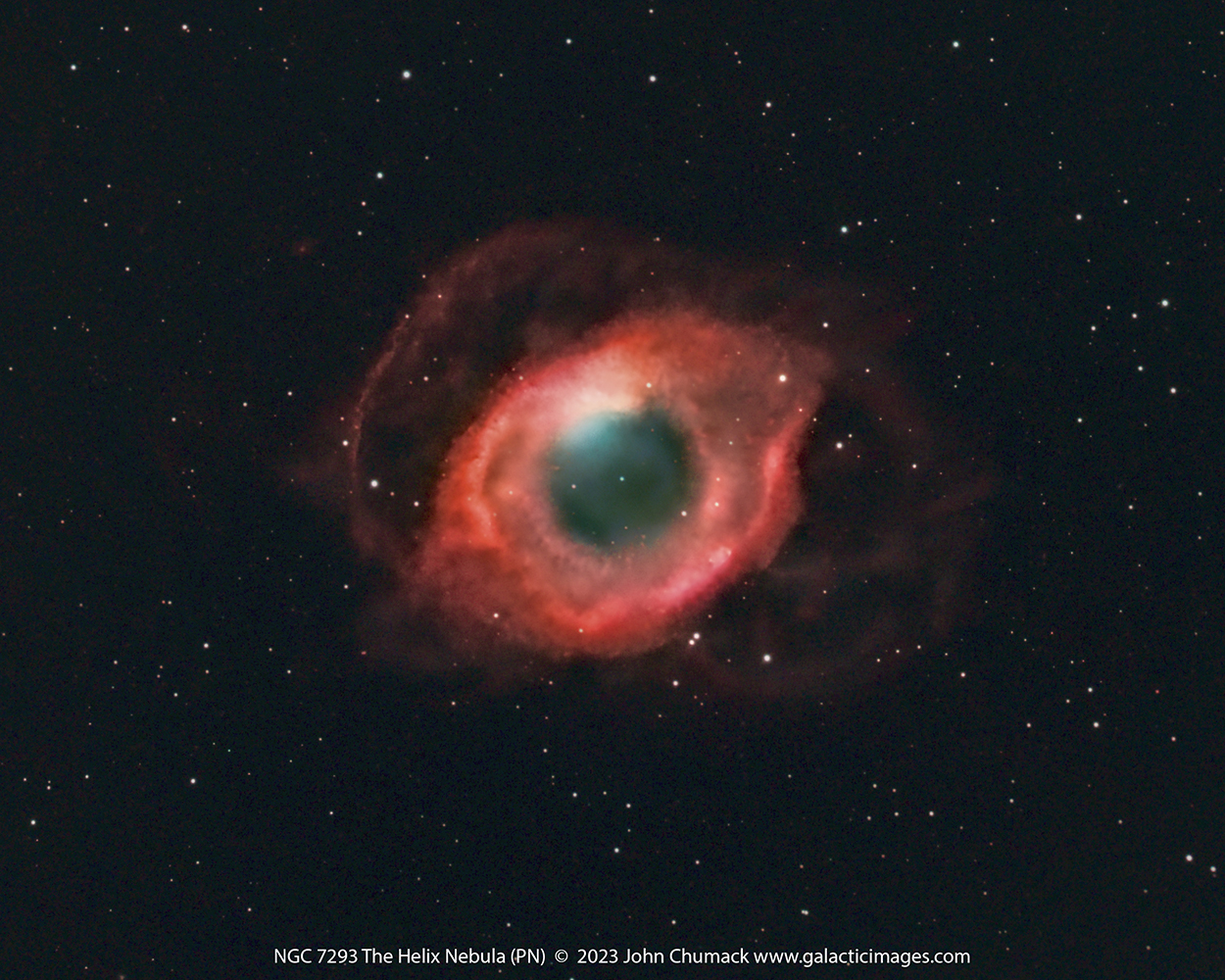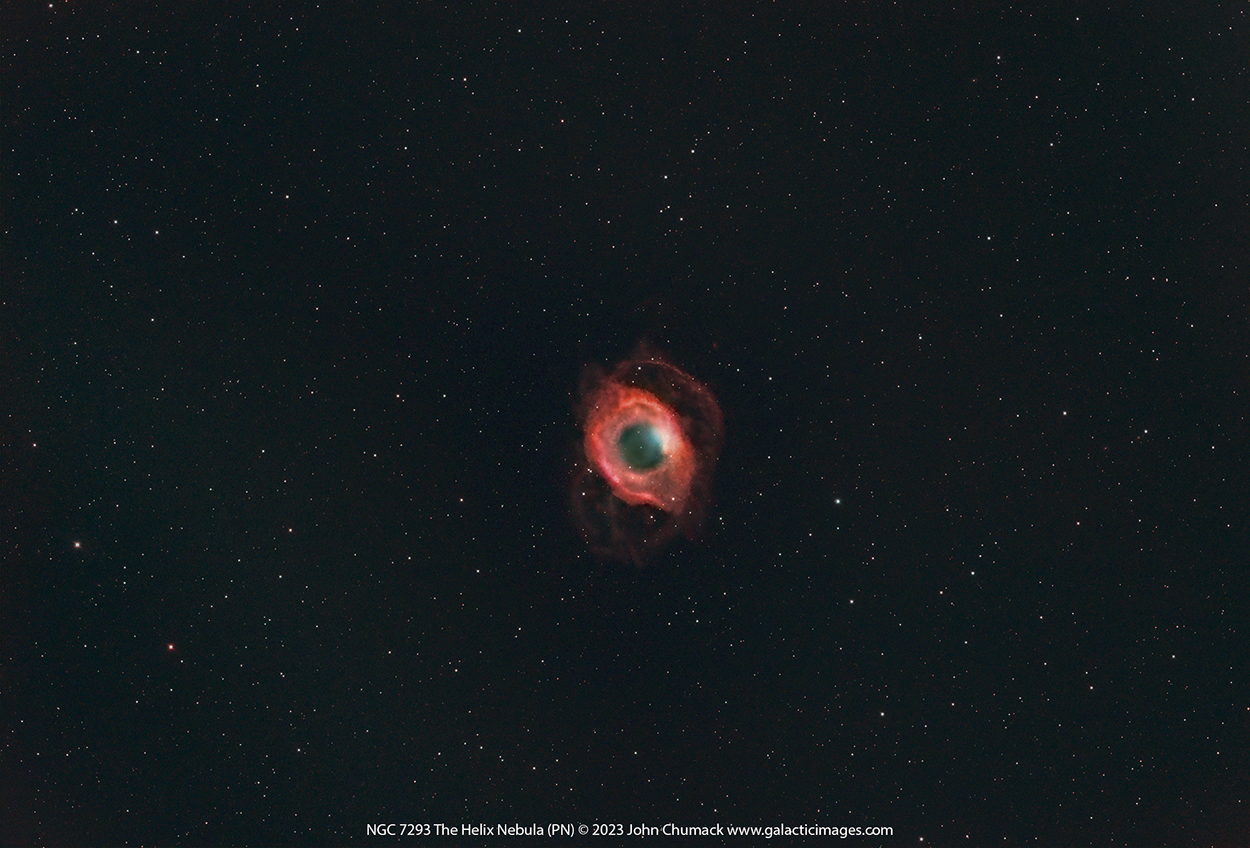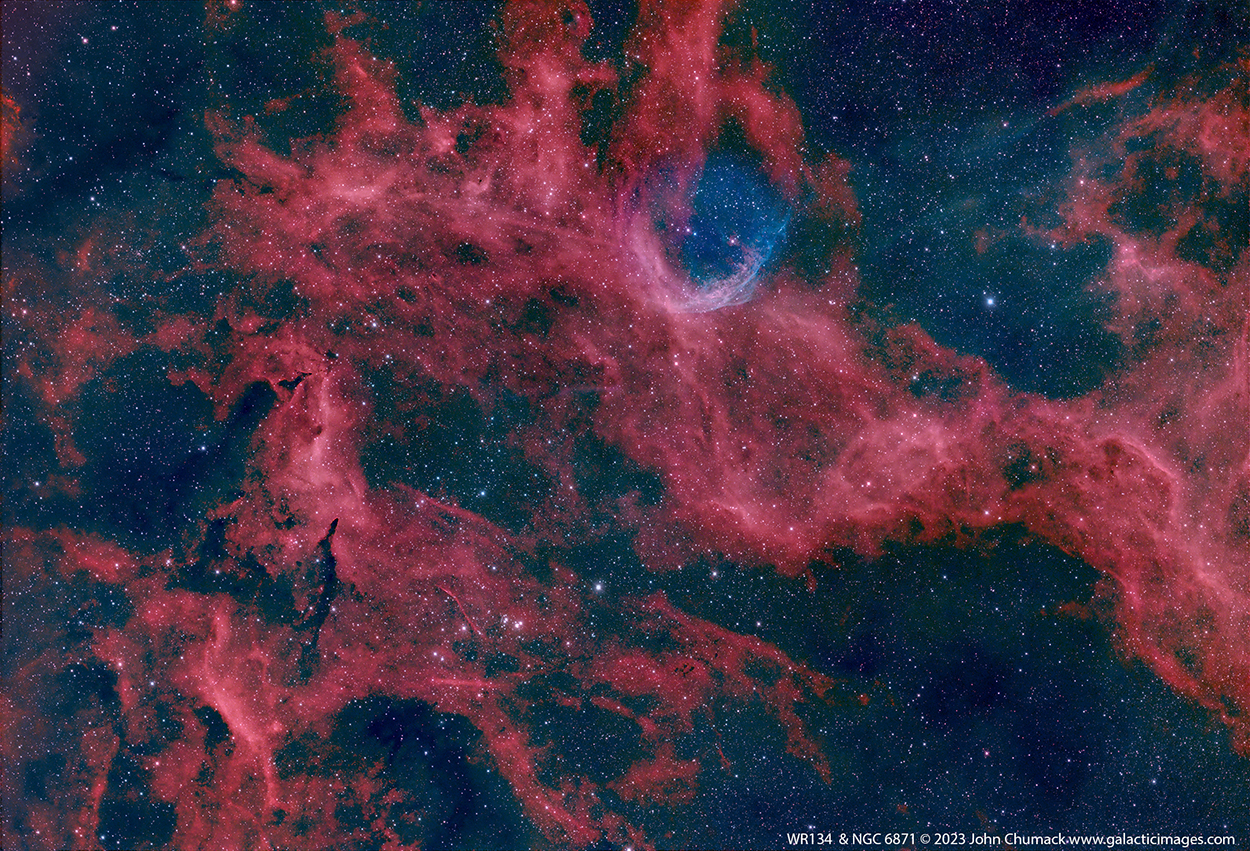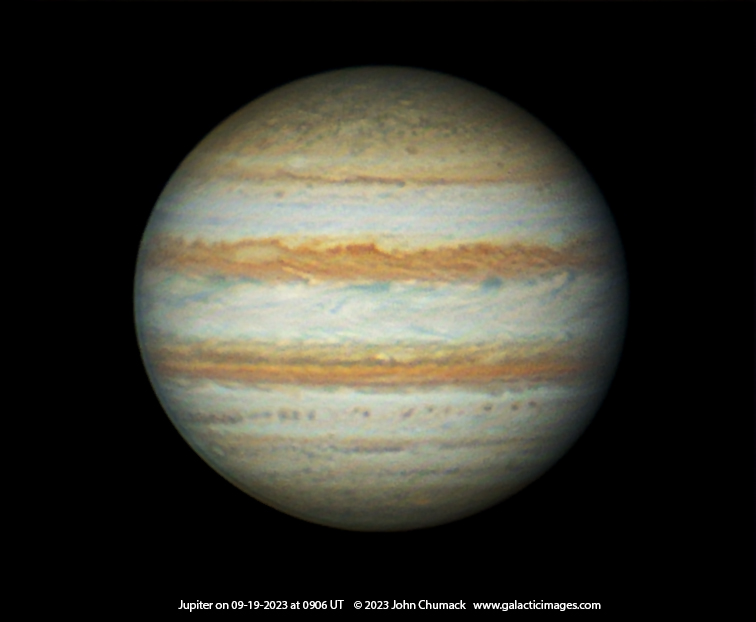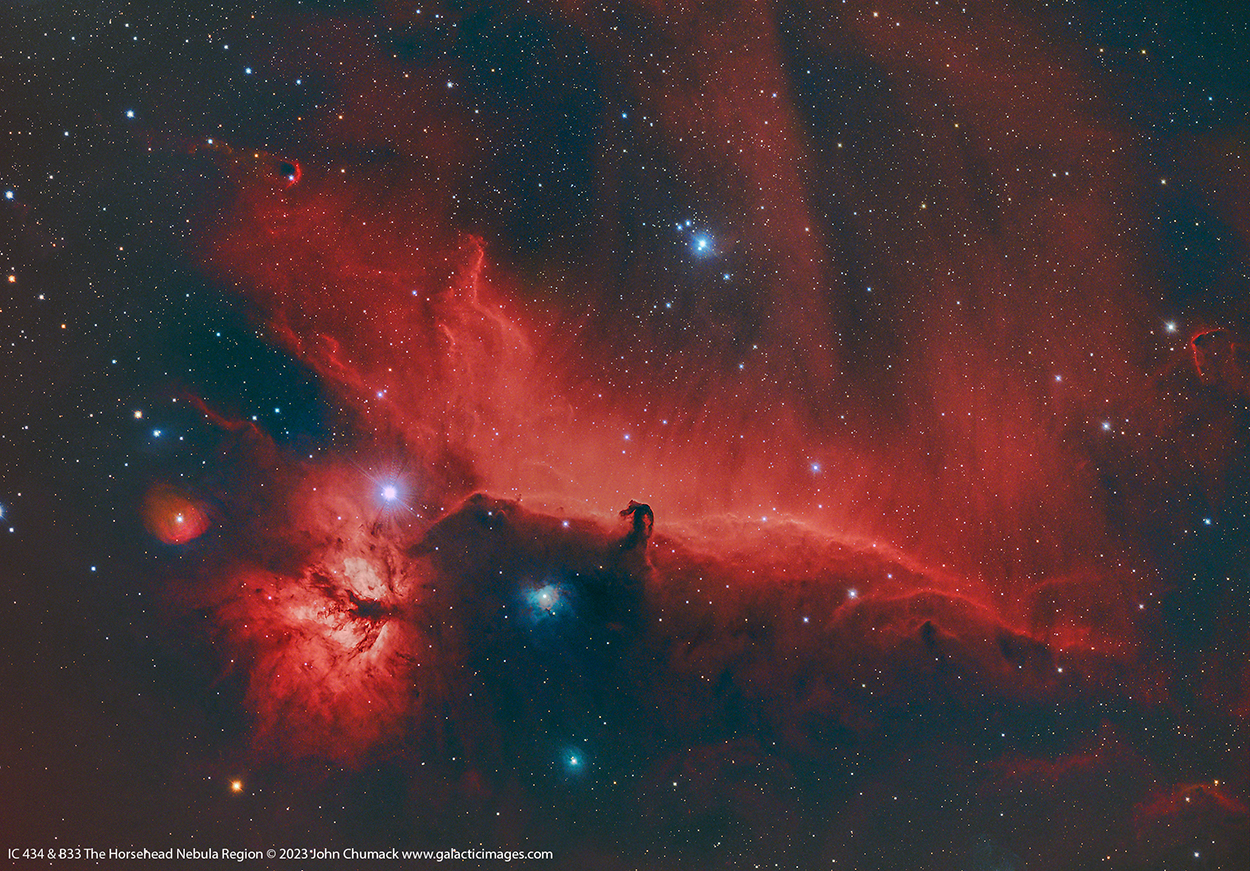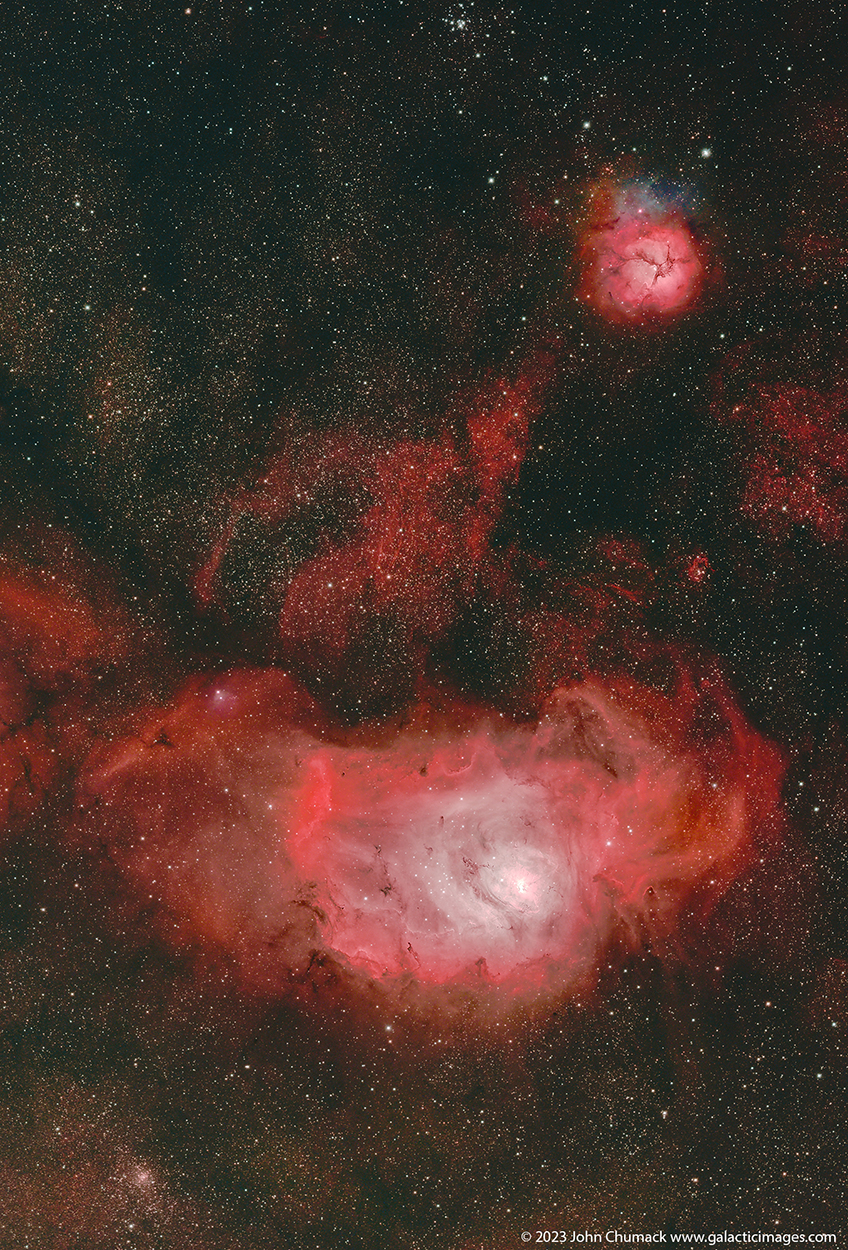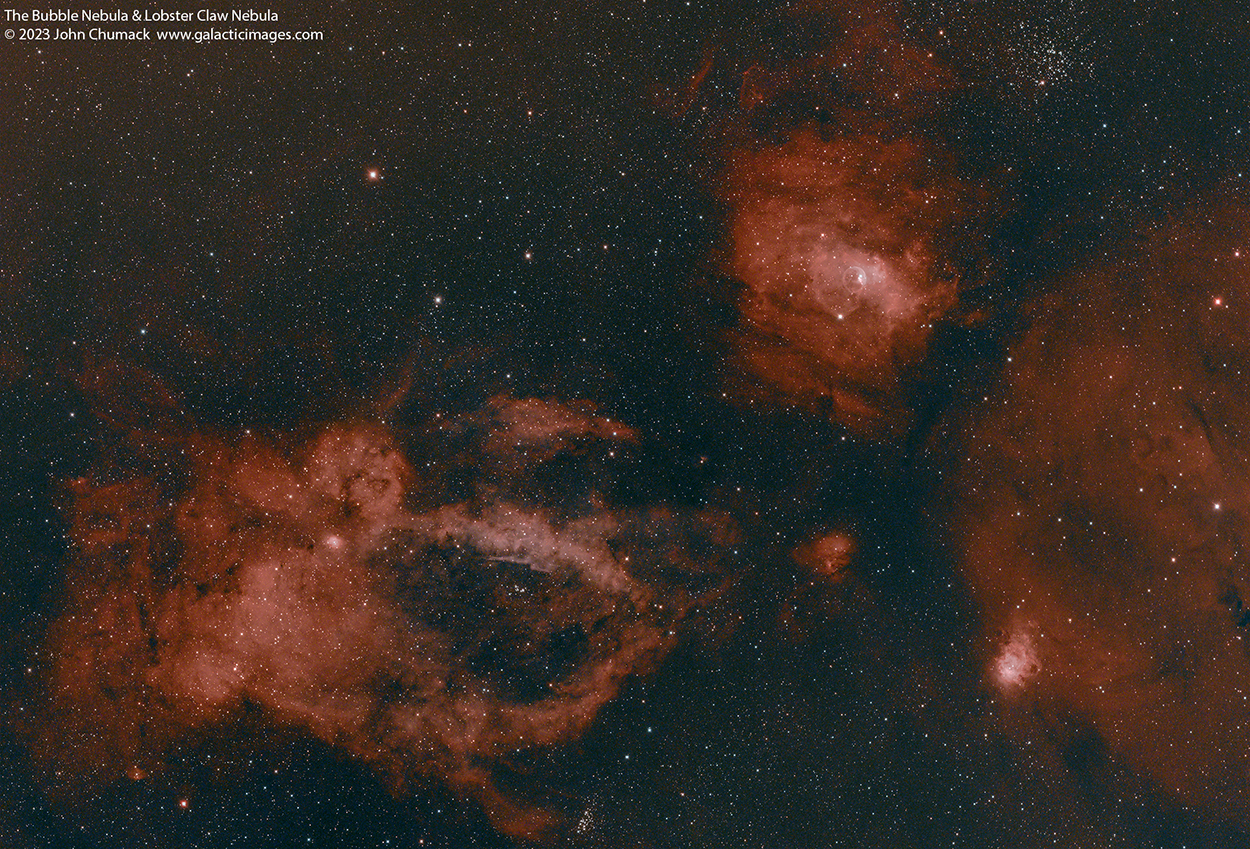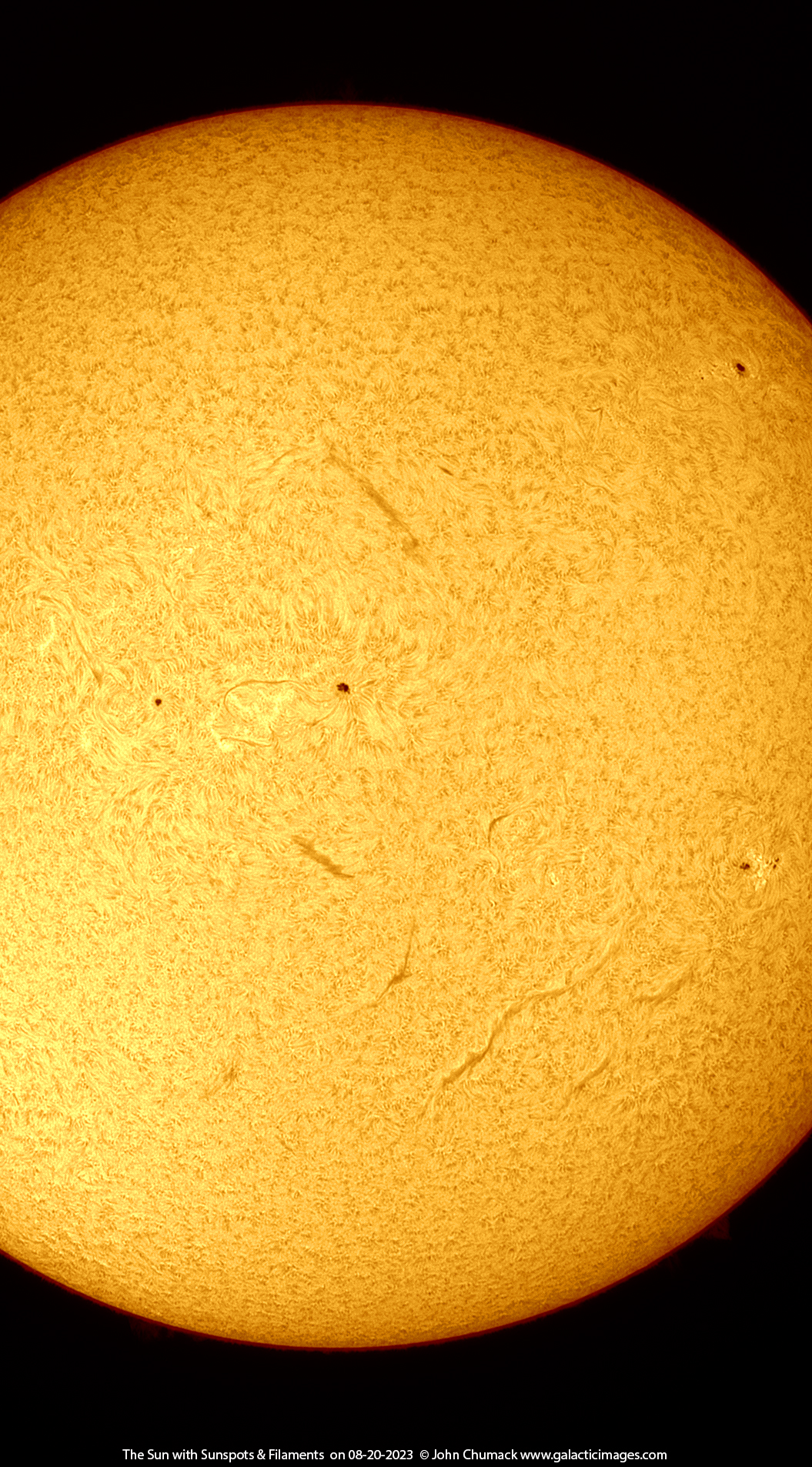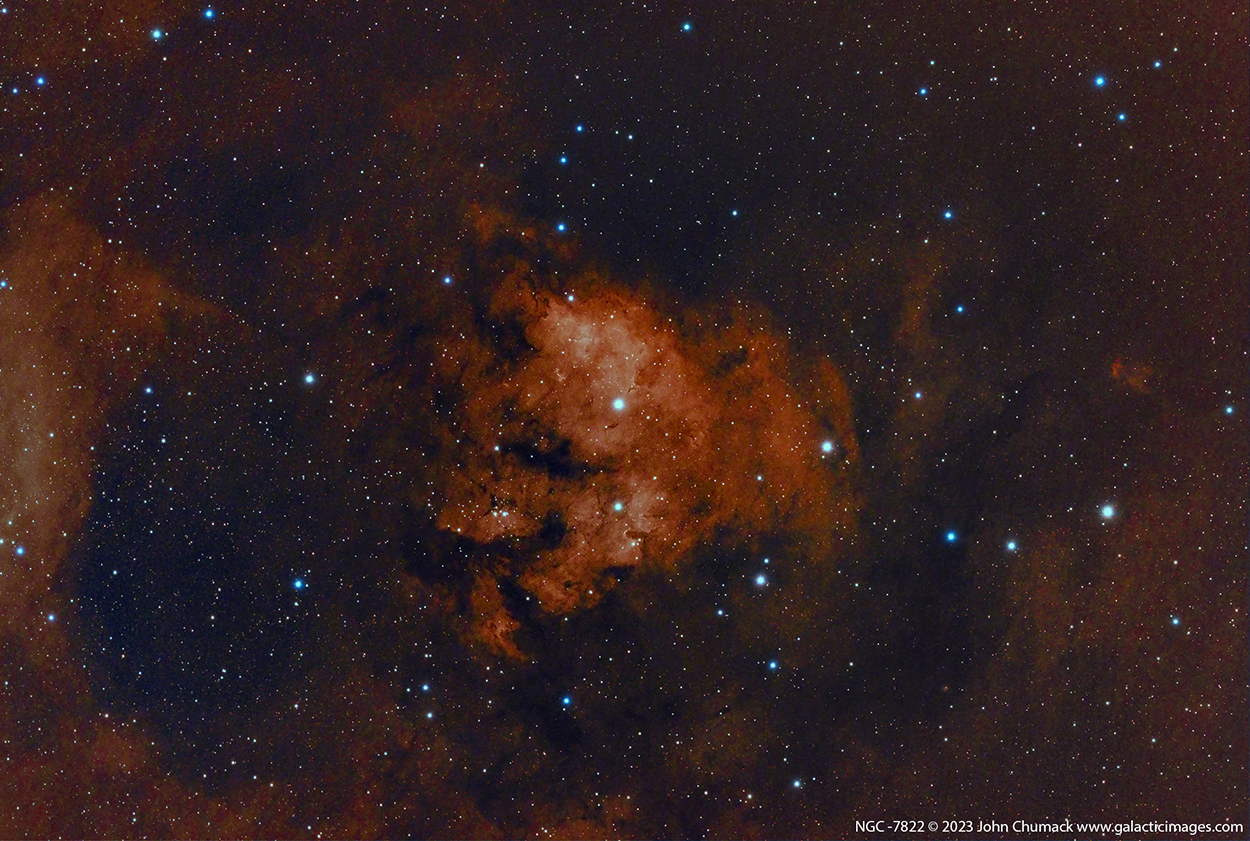NGC 7293 The Helix Nebula(PN) Close-up _The “Eye of God” Nebula
A nice close-up shot of NGC 7293 The Helix Nebula, also known as the “Eye of God”.
This is a large planetary nebula (PN) located in the constellation Aquarius.
This is a dying star blowing off its outer atmosphere!
Discovered by Karl Ludwig Harding, likely before 1824, this object is one of the closest to the Earth of all the bright planetary nebulae.
Based on recent measured expansion rates this Planetary Nebula is about 10,600 years old.
The central star is destined to become a white dwarf.
The estimated distance is about 215 parsecs (700 light-years). It is similar in appearance to the Cat’s Eye Nebula and the Ring Nebula, whose size, age, and physical characteristics are similar to the Dumbbell Nebula, varying only in its relative proximity and the appearance from the equatorial viewing angle.
This will be the fate of our Sun in about 6 billion years from now!!!
Capture Details:
Celestron RASA 8 inch diameter F2.2 Telescope, ZWO AM5 Harmonic Tracking Mount, ZWO 294MC Cooled Cmos Camera, Starizona NBZ UHS Filter, ASI Air Plus, via Ethernet to I-Pad,
12 x 300 second sub exposures, 60 minute total integration time from my observatories at JBSPO in Yellow Springs, Ohio.
The first image is a 70% Crop Close-up from my original wide field shot. One of my best shots of the Helix to date.
Best Regards,
John Chumack
www.galacticimages.com
WR134 Wolf-Rayet Star & NGC 6871 Open Star Cluster in Cygnus
NGC 6871 Open Star Cluster & WR 134 Wolf-Rayet Star with a beautiful section of Nebula In Cygnus.
I really like the structure and dark nebula in this region as well.
NGC 6871 is a small, young open cluster in the constellation of Cygnus. The cluster has fewer than 50 members,
most of which are blue and white stars. It is located 5,135 light-years from Earth. NGC 6871 was born in the same
giant molecular cloud with at least six other open clusters.
WR 134 is a variable Wolf-Rayet star located around 6,000 light years away from Earth in the constellation of Cygnus,
surrounded by a faint blue bubble nebula blown by the intense radiation and fast wind from the star. It is five times the radius of the sun, but due to a temperature over 63,000 K it is 400,000 times as luminous as the Sun.
WR 134 was one of three stars in Cygnus observed in 1867 to have unusual spectra consisting of intense emission lines rather than the more normal continuum and absorption lines.
These were the first members of the class of stars that came to be called Wolf-Rayet stars (WR stars) after Charles Wolf
and Georges Rayet who discovered their unusual appearance.
WR 134 is classified as an Algol type eclipsing variable and given the designation V1769 Cygni, but the variation is not strictly periodic and brightness changes occur on timescales of hours to days.
Capture details:
Celestron RASA 8inch F2.2, ZWO AM5 Harmonic Mount, ZWO 294MC cooled Cmos Camera, Starizona NBZ UHS Filter, ASI Air Plus via Ethernet to IPAD.
24 x 300 sec. Subs, 120 minute total integration time.
Captured from my observatories at JBSPO in Yellow Springs, Ohio on 09-16-2023.
Best Regards,
John Chumack
www.galacticimages.com
Jupiter on 09-19-2023
Jupiter on 09-19-2023
I got up at 4:00am this morning to get a close-up image of Jupiter while it was nice and high in the sky.
it turned out the seeing was decent for a change. I got some nice Jovian cloud top details!!!
Target=Jupiter, Date: 190923, Time: 090647 UT,
Mag: -2.73, Diameter: 46.32″, Res: 0.10″, Az: 197.30, Alt: 64.44,
Phase: 0.99, CM: CMI=163.7° CMII=290.0° CMIII=315.7°,
Camera: QHY5III462C, Scope: C-11, FL: 6150mm, F-ratio: 21, 2x Barlow + ADC,
Fire-Capture Software, 2.8ms exposures, 60sec. SER Video File, Best 70% of 13,546 frames.
Observer: John Chumack, Location: Dayton, Ohio, Comment: very stable seeing for about 1.5 hours
Seeing: 7/10.
Best Regards,
John Chumack
www.galacticimages.com
IC 434 & B33 The Horsehead Nebula Region on 09-16-2023
IC 434 & B33 The Horsehead Nebula Region on 09-16-2023. Put it up full screen to see the details in the nebula clouds. Reminds me of Aurora curtains coming off the dusty mountain beside the horsehead.
The Horsehead nebula is one of the most Identifiable objects in the sky photographically,
but being so faint it is visually challenging for the human eye to see through a telescope, unless under truly dark skies.
IC 434 & B33 (Barnard 33) the dark horsehead is part of a larger molecular cloud region in Orion. This massive star formation region is about 1,500 light years from Earth.
Captured with my RASA 8 inch F2.2 Telescope, AM5 Harmonic Drive Mount, ZWO 294MC Cooled Cmos Camera, ASI Air Plus via Ethernet to I-Pad,
Starizona NBZ UHS Filter, 12 x 300 sec. subs, 60 minute total exposure integration time.
Captured at my observatories at JBSPO in Yellow Springs, Ohio on 09-16-2023. One of the clearest and transparent nights we had in over a year.
Best Regards,
John Chumack
www.galacticimages.com
M20 The Trifid and M8 The Lagoon Nebulae in Sagittarius (08-18-2023)
M20 The Trifid and M8 The Lagoon Nebulae in Sagittarius,
You need to put this up full screen to see the details!!!
M20 The Trifid Nebula(Top) (catalogued as Messier 20 or M20 and as NGC 6514) is an H II region located in Sagittarius.
It was discovered by Charles Messier on June 5, 1764. Its name means ‘divided into three lobes’.
The object is an unusual combination of an open cluster of stars; an emission nebula (the lower, red portion),
a reflection nebula (the upper, blue portion) and a dark nebula (the apparent ‘gaps’ within the emission nebula
that cause the trisected appearance; these dark bands is also designated Barnard 85). This is a very beautiful example of an
Emission & Reflection Nebulae combination.
The Large bright Orange/Pink nebulae near the bottom in this image is M8 The Lagoon Nebulae Complex.
Easily visible to the naked eye from a dark location.
M8 looks great in binoculars or any small telescope, with the most apparent or easily visible is the bright star cluster
and nebulae center.
The Lagoon Nebula (catalogued as Messier 8 or M8, NGC 6523, Sharpless 25, RCW 146, and Gum 72) is a giant interstellar cloud
in the constellation Sagittarius. It is classified as an emission nebula/H II region.(star formation regions)
The Lagoon Nebula was discovered by Giovanni Hodierna before 1654 and is one of only two star-forming nebulae faintly visible
to the eye from mid-northern latitudes. Seen with binoculars, it appears as a distinct oval cloud like patch with a definite core.
Within the nebula is the open cluster NGC 6530.
The Lagoon Nebula is estimated to be about 4,100 light-years away from the Earth. In the sky of Earth, it spans 90′ by 40′,
which translates to an actual dimension of 110 by 50 light years. Like many nebulae, it appears Red/ pink/orange in time-exposure color photos
but is gray to the eye peering through binoculars or a telescope, due to human vision having poor color sensitivity at low light levels.
The nebula contains a number of Bok globules (dark, collapsing clouds of proto-stellar material), the most prominent of which have
been catalogued by E. E. Barnard as B88, B89 and B296. It also includes a funnel-like or tornado-like structure caused by a
hot O-type star that emanates ultraviolet light, heating and ionizing gases on the surface of the nebula. The Lagoon Nebula also
contains at its center a structure known as the Hourglass Nebula.
Although The Lagoon Nebula is a pretty bright nebula, and can be glimpsed near urban areas as a faint fuzzy patch of light,
to really appreciate & enjoy it at its best try to look at it under nice dark skies away from cities or towns!
Want to see more than your eye shows you???
Then try binoculars or a small telescope, or even better yet try to photograph it,
as long exposures photos will always show you more than the human eye can see.
What I really like about this image is the wealth of detail visible in both nebulae, and especially the Dark Nebulae.
Also at the very top edge of the image is M21 Open star cluster, and at the bottom edge is the Globular star cluster NGC 6544.
Captured Details:
Celestron RASA 8 F2.2 Telescope, ZWO AM5 Mount, ZWO 294MC Cooled Cmos Camera, ZWO ASI Air Plus,
via Wi-Fi to I-Pad, 10 x 300 second subs, 50 minute total exposure time.
Captured on 08-18-2023 from my observatories at JBSPO in Yellow Springs, Ohio.
Best Regards,
John Chumack
www.galacticimages.com
NGC-7635 The Bubble Nebula with Sh2-157 The Lobster Claw Nebula
The Bubble Nebula (NGC 7635) is the most famous object in this image, at the top and right of center. The Bubble is surrounded by nebula Sh2-162,
a cloud of glowing hydrogen gas located approximately 10,000 light years away.
The large Open Star cluster M52 is to the upper right of the Bubble, and is located 4,980 light years away.
This Open Star cluster offers a fantastic view in any small telescope.
Sh2-161 Nebula complex is at lower right and the nebula continues off the FOV.
NGC 7538 (Sh2-158) is the very bright patch of nebula near the bottom edge of Sh2-161.
At the bottom left is the massive star formation region known as The Lobster Claw Nebula (Sh2-157), Just beneath the Lobster’s claw is the bright open star cluster NGC 7510.
Half way between the Lobster Claw and The Bubble Nebula is a newborn star(a tiny orange squiggle shaped nebula beside the star) this is Herbig-Haro 170.
Herbig-Haro objects form when gas ejected by the stars collides at high speed with surrounding clouds of gas and dust. You will need to zoom in a little to see this object.
Sh2-159 is a small patch of nebulae lying near center between all three of larger nebulae regions.
Celestron 8 inch F2.2 RASA, ZWO AM5 Mount, ZWO 294MC cooled Cmos Camera, ASI Air Plus via Ethernet to IPAD,
15 x 300 seconds subs exposures, total 75 minutes total integration time. Captured from my observatories at JBSPO in Yellow Springs, Ohio on 08-19-2023.
Best Regards,
John Chumack
www.galacticimages.com
The Sun in Hydrogen Alpha Light on 08-20-2023
The Sun in Hydrogen Alpha Light showing Sunspots & Filaments, Sunspot/ active regions 3411, 3405, 3403, 3409, 3407.
I captured this close-up on 08-20-2023 centered on the activity while the seeing was good that Sunday morning.
Capture details:
Date: 200823, Time: 143203 UT, Camera: QHY5III290M, Scope: Lunt 60mm/50F Hydrogen Alpha Solar Telescope,
BF1200, Single Stack, Fire-Capture, SER video file, 100FPS, 1.044ms exposure, 760 out of 871 frames stacked in Registax6,
Observer: John Chumack, Location: Dayton, Ohio, Comment: no fire/smoke, excellent transparency, Seeing: 8/10.
Best Regards,
John Chumack
www.galacticimages.com
Sh2-132 The Lion Nebula
The last 6 months have been terrible with clouds & fire Smoke…but I still try to shoot something!!!
At least this nebula does look like it’s nickname.
The Lion Nebula Sh2-132 is a faint emission nebula(star formation region) in the constellations of Cepheus, near the border of Lacerta.
It’s distance is between 10,000 and 12,000 light years away.(1 Light year = approximately 5.8 Trillion Miles)
The components of this emission nebula are hydrogen and oxygen gases, which are stimulated to a high energy state by ultra violet light from nearby stars and subsequently re-emit the light.
The darker areas within the nebula are “dark nebulae,” which are dust clouds that obscure light.
Capture Details:
Celestron RASA 8inch F2.2, Software Bisque MyT Mount, ZWO 294MC Cooled Color Cmos Camera, ZWO ASI Air Plus via Ethernet to IPAD, Starizona NBZ UHS Filter, 26 x 300 second subs, 130 minute total integration time taken from my backyard observatory(bortle8), Dayton, Ohio on 08-13-2023.
Best Regards,
John Chumack
www.galacticimages.com
Sharpless 171, NGC-7822 and Berkeley 59
NGC-7822 Emission Nebula in Cepheus
NGC 7822, also known as Cederblad 214 is a young star forming complex in the constellation of Cepheus.
The complex encompasses the emission region designated Sharpless 171 or LBN 589, and the young cluster of stars
named Berkeley 59. The complex is believed to be some 2,900 light-years away.
Its diameter is about 300 light years.
Captured with my RASA 8inch diameter F.2.2 Scope, Bisque MyT Mount, ZWO 294MC cooled Cmos Camera, Starizona NBZ UHS Filter, ASI Air Plus via Wi-Fi to I-Pad,
24 x 300 second Subs, total 2 hour total integration time from my backyard Observatory(bortle8) in Dayton, Ohio on 07-16-2023.
Best Regards,
John Chumack
www.galacticimages.com
IC-1396 Emission Nebula with Mu Cephei and Dark Nebulae
IC-1396 A stunning emission nebula and “Dark” nebula. IC 1396 mixes glowing cosmic gas and dark dust clouds in the high and far off constellation of Cepheus.
This is a large and faint emission nebula, a star forming region that is over 100 light-years across, and is located about 2,400 light-years away from Earth.
Embedded is the star cluster Trumpler 37 near center, and the red super-giant star Mu Cephei, also known as the Garnet Star (at extreme upper right edge).
The nebula gets its power from the star HD206267 near the center of this image.
You can see the Elephant’s Trunk Nebula at the bottom center of this image as well as some nice dark nebula through out the FOV.
We had Fire/smoke haze for weeks and while dodging high thin clouds almost nightly, but I got enough clean data in between to finally put it together.
Celestron RASA 8 inch F2.2 scope, Bisque MyT Mount, ZWO 294 MC cooled Color Cmos Camera, ZWO ASI Air Plus, via Wi-Fi to I-Pad,
38 x 300 second Subs, 3 hours 10 minutes Total integration time. 07-29-2023 to 08-04-2023 from my backyard observatory(bortle8) in Dayton, Ohio.
Best Regards,
John Chumack
www.galacticimages.com


